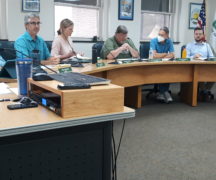By JAN LARSON McLAUGHLIN
BG Independent News
As long as officials can remember, the city has had more miles of roadway than it has funding to maintain.
“It’s a problem that exists in every city in Ohio,” said Bowling Green Public Services Director Joe Fawcett.
In fact, Fawcett recently came across a speech made in the 1970s by then mayor Alvie Perkins about the paving dollars falling short of the need. That same speech can be made every year.
However, with the help of federal American Rescue Plan Act funds, current Mayor Mike Aspacher has proposed a massive one-time boost in paving money – using $3 million of the $7 million projected to come to BG through ARPA.
“A fundamental expectation of local government, in my view, is repair and maintenance of the city’s roads,” Aspacher said when he introduced the plan to City Council early in October.
Over the next three years, the funding will pay for a total of 30 lane miles of road pavement, “spread across the community,” Fawcett said. That will more than double the street paving the city can normally afford – which averages 4.36 miles each year.
“We can attack this on a much larger scale,” Fawcett said. “This is going to catapult us forward.”
On Monday evening, City Council’s Transportation and Safety Committee asked the administration for particulars on how the streets on the paving list made the cut.
To select which streets to include, a pavement rating index was used. This rating identifies residential roads that are in the worst condition, looks at the size and number of cracks, measures traffic volume, and considers street proximities so projects can be pieced together to make attractive paving projects for contractors.
City Council member Bill Herald noted the “washboard” characteristics of some streets, giving them an “amusement park quality.”
The mill and fill work on the streets will fix that, Fawcett said.
Council member Jeff Dennis asked about the longevity of the paving projects, and voiced concerns about the one-time use requirement for the ARPA funding.
“This is all infrastructure we’re going to have to maintain,” Dennis said.
But it was pointed out that no new roads are being built – just older ones are being repaired. And all 30 miles will not be ready for replacement all at once.
While state routes tend to need repaving about every 15 years, residential streets can last 20 to 25 years, City Engineer Brad Holman said.
Fawcett pointed out one residential street – Rosewood – that is still the original pavement poured when the neighborhood was built in 1986.
“Haskins (Road) is going to get repaved more frequently than a Rosewood,” he said.
Herald said the street selection process showed very methodical planning by the city.
“I think this is a shot in the arm to help us get caught up,” he said.
The projects would include improvements to ADA ramps and curb replacements as needed.
The ordinance for the street paving received its second reading by City Council Monday evening. Acting on the projects soon will allow the city to be among the first communities to hire a contractor to begin work as soon as weather allows in 2022, the mayor said.
Suggested road projects for 2022 include:
- Clough Street from South Main to South College.
- Clough Street from Mercer to Campbell Hill.
- Lehman Avenue from South Main to Manville.
- South Summit from Palmer to Wooster.
- North Enterprise from Wooster to Poe.
- Frazee Avenue from North Main to North Enterprise.
- Leroy Street from North Main to North Enterprise.
- Ridge Street from North Enterprise to Thurstin.
- Pike Street from North Enterprise to Thurstin.
- South Enterprise from Lehman to Wooster.
- North Prospect from Wooster to Poe.
- West Evers from Grove to Main.
- East Reed from Prospect to Enterprise.
- North Mitchell Road from Poe to West Wooster.
- North Mitchell Road from Poe to the north corporation line.
- South Mitchell Road from West Wooster to Sand Ridge.
- West Reed Street from Main to Grove.
Possible road projects for 2023 include:
- Finch Street from Wren to Oriole.
- Wren Road from Finch to Ohio 64.
- Swallow Road from Wren to the end.
- Oriole Street from Finch to Wren.
- Warbler Court from the cul-de-sac to Cardinal.
- Cardinal Street from Finch to Oriole.
- Martin Street from Cardinal to Wren.
- Teal Trail from Finch to Cardinal.
- Lafayette Avenue from Conneaut to Finch.
- Oakwood Court from the cul-de-sac to Cedar.
- Rosewood Court from the cul-de-sac to Cedar.
- Dogwood Court from cul-de-sac to Cedar.
- Beech Street from Conneaut to Rosewood Drive.
- Aspen Lane from Rosewood Drive to Cedar.
- Ashwood Lane from Cedar to the end.
- Hickory Court from Cedar to the cul-de-sac.
- Cedar Lane from Conneaut to Rosewood Drive.
- Rosewood Drive from Cedar Lane to south of Margaretha.
- South Orleans from Aspen Lane to Lafayette.
- Garden Court from Wallace to the end.
- Wallace Avenue from Garden to the west end.
- Vine Street from Wallace to the south end.
- Parker Street from Haskins Road to the west end.
- Lambert from Vine to the west end.
- Fairview Avenue from Poe to Van Camp.
- Devonshire Street from Conneaut to the cul-de-sac.
- Tamarac Lane from Conneaut to Devonshire.
- Kensington Boulevard from Devonshire to the butt joint.
- Cobblestone Drive from Devonshire to the cul-de-sac.
- Somerset Street from Cobblestone to the south end.
Potential road projects for 2024 include:
- Pearl Street from Wintergarden to Church Street.
- Sand Ridge Road from Wintergarden to Maple Street.
- West Gypsy Lane from Sand Ridge to west of South Main.
- East Napoleon Road, from Interstate 75 to Dunbridge Road.
- East Gypsy Lane from I-75 to Dunbridge Road.
- South College Avenue from East Wooster to Napoleon Road.
Last month, the mayor also listed a few other projects in the city that could be potentially funded by the ARPA funds. Those include:
- Paving City Park Drive with a side-use path.
- Installing all or a portion of the side-use path from the Community Center to the high school and Cogan’s Crossing.
- Study the impact of changing the downtown right-of-way to allow for an expanded use of the sidewalks outside of stores and restaurants.
Herald asked the city administration to consider sidewalks for other ARPA funding. “We have a similar situation” with too many sidewalks needing repairs and too little funding to do the work.
“Improving sidewalks strategically would meet all of the criteria” and help with neighborhood revitalization, Herald said.





